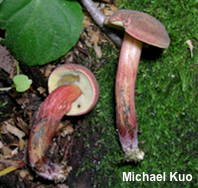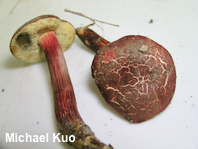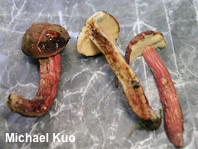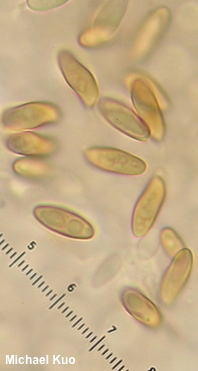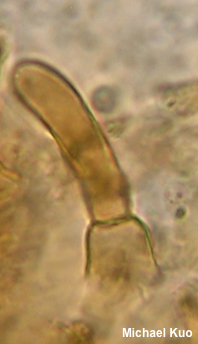| Major Groups > Boletes > Xerocomellus "chrysenteron" |

|
[ Basidiomycota > Boletales > Boletaceae > Xerocomellus . . . ] Xerocomellus "chrysenteron" by Michael Kuo, 27 March 2024 Xerocomellus chrysenteron is a European species; the mushroom featured here is Xerocomellus or Boletus "chrysenteron" in the sense of eastern North American authors. It is a small-ish bolete featuring a brown to olive brown cap that quickly begins to develop a cracked, mosaic-like surface in which pinkish flesh is exposed in the cracks. Other distinguishing features include its blue-bruising pore surface, its general stature (the stem is usually longer than the cap is wide), its association with oaks and other hardwoods, and microscopic features (see below). The true, European Xerocomellus chrysenteron does not bruise blue and is associated primarily with conifers; the similar, bluing, hardwood-associated species is Xerocomellus cisalpinus, described as new in 2003 from Italy, and is a better morphological match for the eastern North American "chrysenteron." However, there are phylogenetic differences (see Frank et al. 2020), and the species described here is probably unnamed. Xerocomellus truncatus, described from North Carolina (Singer et al. 1960), is virtually identical to the naked eye, but features distinctively truncated spores. In western North America, Xerocomellus diffractus is the most common similar species. Description: Ecology: Mycorrhizal with hardwoods, especially oaks, and also sometimes reported with conifers; growing alone, scattered, or gregariously; summer and fall; widely distributed in the United States from the Great Plains eastward, but less common in the southeastern states. The illustrated and described collections are from Michigan, Illinois, and Ohio. Cap: 2–5 cm; convex, becoming broadly convex or almost flat; dry; finely velvety when young, but soon bald; becoming cracked in age, usually conspicuously, with reddish to pinkish flesh showing in the cracks; brown to olive brown or reddish brown. Pore Surface: Pale yellow when young, becoming brownish or olive; bruising blue, sometimes slowly; with 2–3 angular pores per mm; tubes to 5 mm deep. Stem: 4–7 cm long; 0.5-1 cm thick; more or less equal, or with a pinched base; solid; bald; often ridged longitudinally; pinkish red to purplish red; sometimes bruising blue; basal mycelium whitish to yellowish. Flesh: Whitish in cap; yellowish in stem; staining slowly bluish on exposure. Odor and Taste: Not distinctive. Chemical Reactions: Ammonia negative to brownish on cap; negative on flesh. KOH negative to brownish on cap; orangish on flesh. Iron salts olive on cap; negative on flesh. Spore Print: Brown to dark olive brown. Microscopic Features: Spores 10–14 x 3–4 µm; boletoid-fusiform; smooth, or when mature possibly very finely striate (best seen with high magnification and Melzer's reagent); yellowish to golden in KOH; inamyloid. Hymenial cystidia 25–45 x 5–15 µm; fusiform to lageniform; smooth; thin-walled; hyaline to yellowish in KOH. Pileipellis a palisadoderm; elements 2.5–5 µm wide, smooth or encrusted, septate, hyaline to brown-walled in KOH; terminal cells often smaller than subterminal cells, creating an awl-shaped apex. REFERENCES: (Coker & Beers, 1943; Snell & Dick, 1970; Smith & Thiers, 1971; Grund & Harrison, 1976; Smith, Smith & Weber, 1981; Phillips, 1991/2005; Lincoff, 1992; Both, 1993; Barron, 1999; Bessette et al., 2000; Peintner et al., 2003; McNeil, 2006; Miller & Miller, 2006; Šutara, 2008; Kuo & Methven, 2014; Bessette et al., 2016; Baroni, 2017; Frank et al., 2020.) Herb. Kuo 07189401, 09260903, 07271202. This site contains no information about the edibility or toxicity of mushrooms. |
© MushroomExpert.Com |
|
Cite this page as: Kuo, M. (2024, March). Xerocomellus "chrysenteron". Retrieved from the MushroomExpert.Com Web site: http://www.mushroomexpert.com/xerocomellus_chrysenteron.html |
